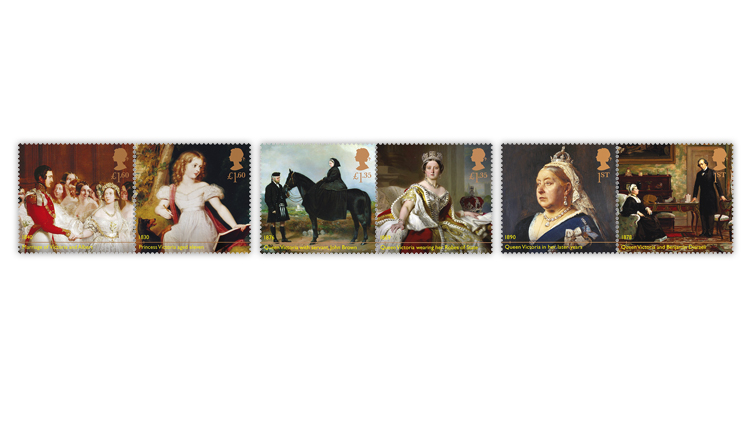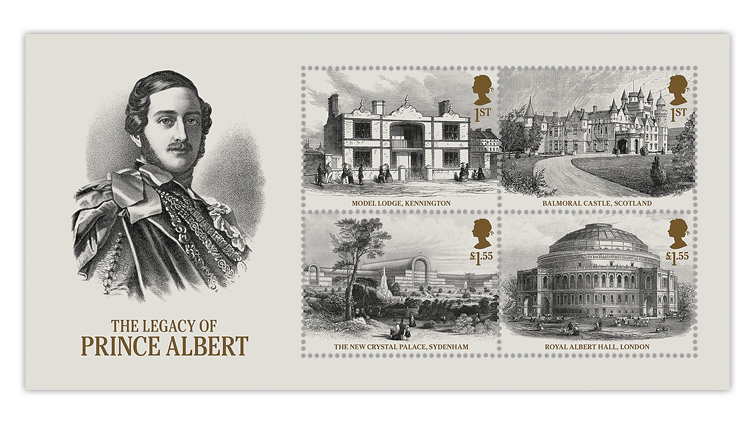World Stamps
New British stamps honor Queen Victoria’s bicentennial
By Denise McCarty
On May 24, Great Britain’s Royal Mail celebrated the 200th anniversary of the birth of Queen Victoria by issuing a set of stamps called Queen Victoria Bicentenary.
Victoria was born Alexandrina Victoria May 24, 1819, at Kensington Palace in London. Her husband, Prince Albert, was born Prince Franz August Karl Albert Emanuel Aug. 26, 1819, in Rosenau Palace near Coburg, Germany. He also is honored by Royal Mail.
In announcing the stamps, Royal Mail said: “We mark two significant bicentenaries in 2019 — the birth of both Queen Victoria and of her husband Prince Albert. Queen Victoria’s reign was the second longest in British royal history and the era named after her saw dramatic social, political and economic change. We mark this anniversary with stamps that chart the life of Victoria from Princess to Empress, and the accompanying miniature [souvenir] sheet stamps celebrate the legacy of Prince Albert.”
The six stamps that “chart the life of Victoria” are in three se-tenant (side-by-side) pairs. The Prince Albert souvenir sheet includes four stamps depicting buildings with a connection to the prince consort.
A prestige booklet called “Victoria: A Long and Glorious Reign” contains 10 stamps, as well as images and text.
The stamps with the highest denomination, £1.60, picture the earliest images of Victoria included in this set.
The stamp on the right of the £1.60 pair shows her as a young princess, age 11. In this 1830 painting by Richard Westall, an artist and the princess’ drawing master, Victoria is sketching with her pet terrier Fanny beside her.
Victoria was 18 when she ascended to the throne on June 20, 1837, upon the death of her uncle King William IV. The coronation was held a year later. Her wedding on Feb. 10, 1840, is featured on the other £1.60 stamp, which depicts a detail from George Hayter’s painting of the ceremony.
The stamp is inscribed at the bottom “Marriage of Victoria and Albert.” Also like all six stamps in se-tenant pairs, it includes a time line at the bottom with the year represented by the design highlighted.
The designs of the stamps in the £1.35 pair are based on paintings from 1859 and 1876, respectively.
The Royal Collection Trust describes the formal 1859 portrait by German painter Franz Xaver Winterhalter: “The Queen is wearing the Robes of State, the circlet, and the earrings and necklace made by Garrard’s, the jewellers in 1858, the year before this was painted. Her left hand rests on some papers, next to the Imperial State Crown, and in the distance we can see a view of Westminster.”
Prince Albert died Dec. 14, 1861, and Queen Victoria remained in mourning, wearing black, until her death 40 years later on Jan. 22, 1901. The 1876 work by Charles Burton Barber shows her in black mourning dress on horseback. Her Scottish servant, John Brown, is also pictured.
On the right-hand stamp in the nondenominated first-class pair, the queen is shown two years later, in 1878, with Prime Minister Benjamin Disraeli at Osborne House from a painting by Theodore Blake Wirgman.
The final stamp in chronological order depicts Baron Heinrich von Angeli’s 1890 portrait of the queen.
The London design firm Webb & Webb Design designed these six stamps. International Security Printers printed them by lithography in sheets of 60, sold in panes of 30 at most postal outlets. The stamps are square, 35 millimeters by 35mm, and are perforated gauge 14.5.
Designed by Common Curiosity, a graphic design studio based in Birmingham and London, the souvenir sheet shows an illustration of Prince Albert at age 22 in the selvage. “The Legacy of Prince Albert” is printed in gold under this black-and-white illustration.
The top two stamps are nondenominated first-class stamps depicting the Model Lodge, Kennington, and Balmoral Castle in Scotland, respectively.
The lodge has served as the headquarters of Trees for Cities since 2013.
On its website, the charity said: “The lodge was originally constructed as a ‘Model Housing for Families’ and displayed at the Great Exhibition of 1851 before being moved to Kennington Park.
“The prototype design was commissioned by Prince Albert as president of the Society for Improving the Condition of the Labouring Classes. It has influenced housing design and construction around the world … ”
In 1852, Prince Albert purchased an estate in Scotland for Queen Victoria. The next year, construction on the new royal residence, Balmoral Castle, began and was completed in 1856.
The first of the two £1.55 stamps features the Crystal Palace, the home of the Great Exhibition of 1851 organized by Henry Cole and Prince Albert.
The other £1.55 stamp shows Royal Albert Hall, the concert hall that opened in 1871 in London.
International Security Printers printed the souvenir sheet by lithography. The sheet measures 146mm by 74mm, and the stamps are 41mm by 30mm each, perforated gauge 14.5 by 14.
The £1.35 stamps pay the international rate for letters weighing up to 10 grams and letters to Europe weighing up to 20 grams, the £1.55 stamps pay the international rate for letters weighing up to 20 grams, and the £1.60 stamps pay the rate for mail to Europe weighing up to 100 grams. The domestic first-class rate is 70 pence.
The 20-page prestige booklet includes four panes of stamps and text by historian Helen Rappaport.
One pane includes the four stamps from the souvenir sheet, and another is a pane of nine stamps with a central label showing a photograph of Victoria and Albert.
The nine stamps include four Queen Elizabeth II definitives (two 2-penny and two 50p) and four first-class stamps showing a young Queen Victoria as she appeared on the world’s earliest stamps of 1840 and 1841. The latter designs are from commemoratives issued in 2015 and 2016 to mark the 175th anniversaries of the 19th-century stamps.
The other two panes contain the stamps from the se-tenant pairs, with the two £1.65 stamps and the £1.35 stamp showing the 1859 portrait on one pane; and the remaining £1.35 denomination and the two first-class stamps on the other.
Royal Mail is offering various other products in conjunction with the Queen Victoria Bicentenary stamps, including first-day covers; 11 postcards reproducing the designs of the 10 stamps and the souvenir sheet; and a presentation pack with the six stamps and the souvenir sheet.
To order the stamps and related products, visit Royal Mail’s web shop. Ordering information also is available from Royal Mail, Tallents House, 21 S. Gyle Crescent, Edinburgh, EH12 9PB, Scotland. Royal Mail’s agency in the United States is Interpost, Box 400, Hewlett, NY 11557.
Connect with Linn’s Stamp News:
Sign up for our newsletter
Like us on Facebook
Follow us on Twitter
MORE RELATED ARTICLES
Headlines
-
US Stamps
Oct 7, 2024, 3 PMMcMurtrie dismissed as APS education director following Sept. 21 arrest
-
US Stamps
Oct 7, 2024, 12 PMVasiliauskas named president of Mystic Stamp Co.
-
US Stamps
Oct 6, 2024, 5 PMApgar souvenir card available
-
US Stamps
Oct 6, 2024, 4 PMFirst Continental Congress and U.N. stamps receive Scott catalog numbers










